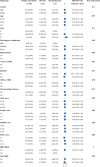A single preoperative low-dose dexamethasone may reduce the incidence and severity of postoperative delirium in the geriatric intertrochanteric fracture patients with internal fixation surgery: an exploratory analysis of a randomized, placebo-controlled trial
- PMID: 37337260
- PMCID: PMC10280884
- DOI: 10.1186/s13018-023-03930-2
A single preoperative low-dose dexamethasone may reduce the incidence and severity of postoperative delirium in the geriatric intertrochanteric fracture patients with internal fixation surgery: an exploratory analysis of a randomized, placebo-controlled trial
Abstract
Objective: Postoperative delirium (POD) is a common complication along with poor prognosis in geriatric intertrochanteric fracture (ITF) patients. However, the prevention and treatment of POD remain unclear. Previous studies have confirmed that POD is essentially a consequence of neuro-inflammatory responses. Dexamethasone is a glucocorticoid with comprehensive anti-inflammatory effects, while a high dose of dexamethasone correlates with many side effects or even adverse consequences. Thus, this prospective study aims to discuss whether a single preoperative low-dose dexamethasone can reduce the impact of POD on geriatric ITF patients with internal fixation surgery.
Methods: Between June 2020 and October 2022, there were 219 consecutive ITF patients assessed in our department. Of the 219 ITF patients, 160 cases who met the inclusion and exclusion criteria were finally enrolled and randomly allocated to the dexamethasone group and the placebo group (80 geriatric ITF patients in each group) in this prospective study. The patients in the dexamethasone group received intravenous 10 mg (2 ml) dexamethasone while the patients in the placebo group received intravenous 2 ml saline in 30 min before being sent to the operating room, respectively. The baseline characteristics, surgical information, incidence and severity of POD as the efficacy-related outcomes, and infection events and hyperglycemia as safety-related outcomes (adverse events), were collected and analyzed between the two groups. The severity of POD was evaluated by Memorial Delirium Assessment Scale (MDAS) score.
Results: There were no differences in baseline characteristics and surgical information between the dexamethasone group and the placebo group. The dexamethasone group had a lower incidence of POD than the placebo group within the first 5 days after surgery [(9/80, 11.3% vs. 21/80, 26.3%, RR = 0.83, 95% CI 0.71-0.97, P = 0.015]. The dexamethasone group had lower MDAS scores (Mean ± SD) than the placebo group [13.2 ± 1.0 (range 11 to 15) vs. 15.48 ± 2.9 (range 9 to 20), P = 0.011, effect size = 0.514]. There were no differences in infection events and hyperglycemia between the two groups.
Conclusions: A single preoperative low-dose dexamethasone may reduce the incidence and severity of POD in geriatric ITF patients with internal fixation surgery.
Trial registration: ChiCTR2200055281.
Keywords: Dexamethasone; Intertrochanteric fractures; Postoperative delirium; The elderly.
© 2023. The Author(s).
Conflict of interest statement
The authors have no relevant financial or non-financial interests to disclose.
Figures
Similar articles
-
The impact of preoperative single low-dose dexamethasone on in-hospital prognosis in geriatric intertrochanteric fracture patients: Analysis of secondary outcomes in a randomized controlled trial.Surgery. 2023 Oct;174(4):1041-1049. doi: 10.1016/j.surg.2023.06.013. Epub 2023 Jul 21. Surgery. 2023. PMID: 37481423 Clinical Trial.
-
Steroids to reduce the impact on delirium (STRIDE): a double-blind, randomised, placebo-controlled feasibility trial of pre-operative dexamethasone in people with hip fracture.Anaesthesia. 2021 Aug;76(8):1031-1041. doi: 10.1111/anae.15465. Epub 2021 Apr 25. Anaesthesia. 2021. PMID: 33899214 Clinical Trial.
-
Preoperative prognostic nutritional index value as a predictive factor for postoperative delirium in older adult patients with hip fractures: a secondary analysis.BMC Geriatr. 2024 Jan 4;24(1):21. doi: 10.1186/s12877-023-04629-z. BMC Geriatr. 2024. PMID: 38178002 Free PMC article.
-
Neuraxial versus general anesthesia in elderly patients undergoing hip fracture surgery and the incidence of postoperative delirium: a systematic review and stratified meta-analysis.BMC Anesthesiol. 2023 Jul 22;23(1):250. doi: 10.1186/s12871-023-02196-9. BMC Anesthesiol. 2023. PMID: 37481517 Free PMC article.
-
Effects of dexamethasone on post-operative cognitive dysfunction and delirium in adults following general anaesthesia: a meta-analysis of randomised controlled trials.BMC Anesthesiol. 2019 Jun 29;19(1):113. doi: 10.1186/s12871-019-0783-x. BMC Anesthesiol. 2019. PMID: 31253079 Free PMC article.
Cited by
-
Effects of intravenous glucocorticoids on postoperative delirium in adult patients undergoing major surgery: a systematic review and meta-analysis with trial sequential analysis.BMC Anesthesiol. 2023 Dec 6;23(1):399. doi: 10.1186/s12871-023-02359-8. BMC Anesthesiol. 2023. PMID: 38057700 Free PMC article.
-
Effect of preoperative oral carbohydrate on postoperative delirium in elderly patients undergoing lower extremity orthopedic surgery: a prospective randomized trial.J Orthop Surg Res. 2025 Feb 22;20(1):191. doi: 10.1186/s13018-025-05614-5. J Orthop Surg Res. 2025. PMID: 39987105 Free PMC article. Clinical Trial.
-
Effects of glucocorticoids on postoperative delirium in patients undergoing elective non-cardiac surgery:A systematic review and meta-analysis.Heliyon. 2024 Dec 5;10(24):e40914. doi: 10.1016/j.heliyon.2024.e40914. eCollection 2024 Dec 30. Heliyon. 2024. PMID: 39735626 Free PMC article.
-
Advances in research on the pathogenesis and signaling pathways associated with postoperative delirium (Review).Mol Med Rep. 2025 Aug;32(2):220. doi: 10.3892/mmr.2025.13585. Epub 2025 Jun 6. Mol Med Rep. 2025. PMID: 40476568 Free PMC article. Review.
-
Postoperative neurocognitive disorders in the elderly: how can we stop the harm? A literature review.Front Med (Lausanne). 2025 Mar 6;12:1525639. doi: 10.3389/fmed.2025.1525639. eCollection 2025. Front Med (Lausanne). 2025. PMID: 40115783 Free PMC article. Review.
References
Publication types
MeSH terms
Substances
Grants and funding
LinkOut - more resources
Full Text Sources
Medical
Miscellaneous




